
通过题目描述的问题,使用栈来解决是最优解。
思路:1)找到左括号们,将其入栈,遇到右括号就开始依次出栈,如果不符合匹配标准,就返回false
2)匹配过程中,会出现栈内数据为空但是需要从站内取数据的情况,出现遍历字符串结束后,栈内数据不为空的情况都需要额外考虑。
画图:

针对思路2的要额外处理
代码:
typedef int STDataType;
typedef struct Stack
{
STDataType* a;
int top;//栈顶
int capacity;//容量
}Stack;
void StackInit(Stack* ps)
{
ps->a = NULL;
ps->capacity = ps->top = 0;
}
//销毁
void StackDestroy(Stack* ps)
{
free(ps->a);
ps->a = NULL;
ps->capacity = ps->top = 0;
}
//入栈
void StackPush(Stack* ps, STDataType x)
{
//断言
assert(ps);
//判断是否需要扩容
if (ps->top == ps->capacity)
{
int newcapacity = ps->capacity == 0 ? ps->capacity = 4 : ps->capacity * 2;
STDataType* tmp = (STDataType*)realloc(ps->a, sizeof(STDataType) * newcapacity);
//判断扩容是否成功
if (tmp == NULL)
{
printf("realloc fail\n");
exit(-1);
}
ps->a = tmp;
ps->capacity = newcapacity;
}
//插入数据
//数组的下标从0开始,top指向的就是栈顶
ps->a[ps->top] = x;
ps->top++;
}
//出栈
void StackPop(Stack* ps)
{
assert(ps);
//断言栈是否为空
assert(ps->top > 0);
ps->top--;
}
//获取栈顶元素
STDataType StackTop(Stack* ps)
{
assert(ps);
//断言栈是否为空
assert(ps->top);
return ps->a[ps->top-1];
}
//检测栈是否为空
bool StackEmpty(Stack* ps)
{
assert(ps);
非空
//if (ps->top > 0)
//{
// return false;
//}
为空
//else
// return true;
//更优化的写法
return ps->top == 0;
}
int StackSize(Stack* ps)
{
assert(ps);
//返回个数,top指的是栈顶数据的下一位。
return ps->top;
}
bool isValid(char * s){
Stack st;
StackInit(&st);//初始化
while(*s!='\0')//遍历
{
if(*s=='{'||*s=='['||*s=='(')
{
StackPush(&st,*s);//当为{,[,( 时入栈
s++;//更新
}
else
{
if(!StackEmpty(&st))//当栈不为空时
{
char top = StackTop(&st);//取出栈顶数据
StackPop(&st);//删除栈顶数据
if((top == '{'&& *s!='}')||(top == '('&&*s!=')'||top == '['&&*s!=']'))//如果不匹配,就返回false
{
return false;
}
else
{
s++;
}
}
else//当栈为空时,说明其缺少左括号,必然不能配对
return false;
}
}
//循环结束时
int ret = StackEmpty(&st);//记录栈是否为空
StackDestroy(&st);//销毁栈
if(ret)//当栈为空,即结束了匹配
return true;
else//栈内有数据,就说明循环结束时,原字符串有单个左括号无法被匹配。
return false;
}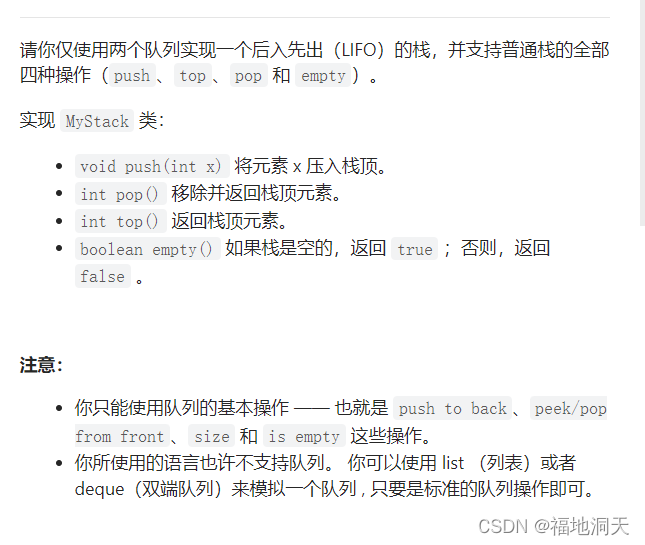
思路:队列的性质是:先入先出;栈的性质是:后入后出。
可以创建两个队列,先使用一个存数据,要取出数据时,可以将前N-1个数据移到另一个队列,取出(并删除)数据,以此往复,模拟实现栈的相关功能。
画图:
移除并返回栈顶元素:
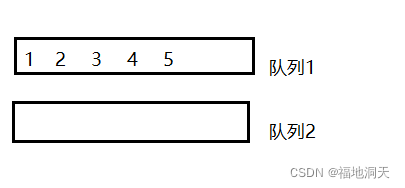
取出5
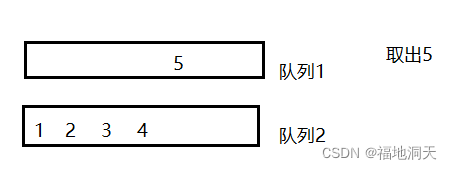
将队列1中的数据清空
插入数据:
刚开始可以随意选择一个空的队列插入,在后面插入的元素都必须插入到非空队列中。
这里可以通过选择语句确立空与非空队列。
返回栈顶元素:
队列拥有访问队尾元素的功能,所以可以直接通过队列来实现。
判断是否为空:
队列1和 队列2 同时为空时,栈为空。
代码:
typedef int QDataType;
//链表的节点
typedef struct QueueNode
{
QDataType data;//数据
struct QueueNode* next;//标记下一个节点
}QNode;
typedef struct Queue
{
QNode* head;//头指针
QNode* tail;//尾指针
}Queue;
void QueueInit(Queue* pq)
{
assert(pq);
pq->head = pq->tail = NULL;
}
void QueueDestory(Queue* pq)
{
assert(pq);
QNode* cur = pq->head;
while (cur)
{
QNode* next = cur->next;
free(cur);
cur = next;
}
pq->head = pq->tail = NULL;
}
void QueuePush(Queue* pq, QDataType x)
{
assert(pq);
QNode* newnode = (QNode*)malloc(sizeof(QNode));
assert(newnode);
newnode->data = x;
newnode->next = NULL;
if (pq->tail == NULL)
{
assert(pq->head == NULL);
pq->head = pq->tail = newnode;
}
else
{
pq->tail->next = newnode;
pq->tail = newnode;
}
}
void QueuePop(Queue* pq)
{
assert(pq);
assert(pq->head && pq->tail);
if (pq->head->next == NULL)
{
free(pq->head);
pq->head = pq->tail = NULL;
}
else
{
QNode* next = pq->head->next;
free(pq->head);
pq->head = next;
}
}
bool QueueEmpty(Queue* pq)
{
assert(pq);
//return pq->head == NULL && pq->tail == NULL;
return pq->head == NULL;
}
size_t QueueSize(Queue* pq)
{
assert(pq);
QNode* cur = pq->head;
size_t size = 0;
while (cur)
{
size++;
cur = cur->next;
}
return size;
}
QDataType QueueFront(Queue* pq)
{
assert(pq);
assert(pq->head);
return pq->head->data;
}
QDataType QueueBack(Queue* pq)
{
assert(pq);
assert(pq->tail);
return pq->tail->data;
}
typedef struct {
//创建两个队列
Queue q1;
Queue q2;
} MyStack;
MyStack* myStackCreate() {
//为结构体分配空间,不能使用
//MyStack st; 栈上开辟的临时变量,出栈即销毁,返回的指针为空指针。
//在堆上开辟空间,malloc动态开辟
MyStack* pst = (MyStack*)malloc(sizeof(MyStack));
//assert(pst);//可有可无
//Mystack结构体成员初始化
QueueInit(&pst->q1);
QueueInit(&pst->q2);
return pst;
}
void myStackPush(MyStack* obj, int x) {
//非空的队列放入数据,始终保持存在一个空的队列
if(!QueueEmpty(&obj->q1))//非空
{
QueuePush(&obj->q1,x);
}
else
{
QueuePush(&obj->q2,x);
}
}
int myStackPop(MyStack* obj) {
//assert(obj);
//指定一个空队列和非空队列,定义q1为空
Queue* empty = &obj->q1;
Queue* nonempty = &obj->q2;
//若不是,就交换
if(!QueueEmpty(&obj->q1))
{
empty = &obj->q2;
nonempty = &obj->q1;
}
while(QueueSize(nonempty)>1)//从非空队列中持续取数据放入空队列中,并删数据
{
QDataType front = QueueFront(nonempty);//获取数据
QueuePush(empty,front);//插入数据
QueuePop(nonempty);//删数据
}
//获取“栈顶”数据
QDataType top = QueueFront(nonempty);
移除栈顶数据
QueuePop(nonempty);
//返回“栈顶”元素
return top;
}
int myStackTop(MyStack* obj) {
//指定一个空队列和非空队列,定义q1为空
Queue* empty = &obj->q1;
Queue* nonempty = &obj->q2;
//若不是,就交换
if(!QueueEmpty(&obj->q1))
{
empty = &obj->q2;
nonempty = &obj->q1;
}
return QueueBack(nonempty);
}
bool myStackEmpty(MyStack* obj) {
assert(obj);
//当q1和q2同时为空时,“栈”为空
return QueueEmpty(&obj->q1) && QueueEmpty(&obj->q2);
}
void myStackFree(MyStack* obj) {
//释放内存时,先解决结构体内部的q1和q2
assert(obj);
QueueDestory(&obj->q1);
QueueDestory(&obj->q2);
free(obj);
//置空并不会改变实参的状态
}

思路:栈的性质:后入后出;队列的性质:先入先出。
创立两个栈,在两个栈上模拟实现队列的基本功能。
画图:
先入1 2 3 4 5 数据
pop

取出队头元素1
将栈1的所有元素移植至栈2

从栈二中提取目标元素1
peek
通过pop可以看出,栈2中的数据可以模仿队列出数据。
由此可以得出结论:模拟实现队列只需要导数据1次即可。
?
push
?
根据已有的结论,将数据先导入栈1中,等到栈2中的数据被删空时再将栈1中的数据导入栈2中。
?
empty
栈1 和 栈2 同时为空时队列为空。
?
注意:在pop和 push数据时,要判断是否为空的情况。
?
代码:
typedef int STDataType;
typedef struct Stack
{
STDataType* a;
int top;//栈顶
int capacity;//容量
}Stack;
void StackInit(Stack* ps)
{
ps->a = NULL;
ps->capacity = ps->top = 0;
}
//销毁
void StackDestroy(Stack* ps)
{
free(ps->a);
ps->a = NULL;
ps->capacity = ps->top = 0;
}
//入栈
void StackPush(Stack* ps, STDataType x)
{
//断言
assert(ps);
//判断是否需要扩容
if (ps->top == ps->capacity)
{
int newcapacity = ps->capacity == 0 ? ps->capacity = 4 : ps->capacity * 2;
STDataType* tmp = (STDataType*)realloc(ps->a, sizeof(STDataType) * newcapacity);
//判断扩容是否成功
if (tmp == NULL)
{
printf("realloc fail\n");
exit(-1);
}
ps->a = tmp;
ps->capacity = newcapacity;
}
//插入数据
//数组的下标从0开始,top指向的就是栈顶
ps->a[ps->top] = x;
ps->top++;
}
//出栈
void StackPop(Stack* ps)
{
assert(ps);
//断言栈是否为空
assert(ps->top > 0);
ps->top--;
}
//获取栈顶元素
STDataType StackTop(Stack* ps)
{
assert(ps);
//断言栈是否为空
assert(ps->top);
return ps->a[ps->top-1];
}
//检测栈是否为空
bool StackEmpty(Stack* ps)
{
assert(ps);
非空
//if (ps->top > 0)
//{
// return false;
//}
为空
//else
// return true;
//更优化的写法
return ps->top == 0;
}
int StackSize(Stack* ps)
{
assert(ps);
//返回个数,top指的是栈顶数据的下一位。
return ps->top;
}
typedef struct {
Stack s1;//储存数据最初始的栈
Stack s2;//取数据专用的栈
} MyQueue;
bool myQueueEmpty(MyQueue* obj);
MyQueue* myQueueCreate() {
//分配空间
MyQueue* obj = (MyQueue*)malloc(sizeof(MyQueue));
//初始化
StackInit(&obj->s1);//放数据
StackInit(&obj->s2);
return obj;
}
void myQueuePush(MyQueue* obj, int x) {
//插入数据,s1为储存初始数据的栈
StackPush(&obj->s1,x);
}
int myQueuePop(MyQueue* obj) {
//如果s2为空
if(StackEmpty(&obj->s2))
{
//导数据
while(StackSize(&obj->s1))
{
int top = StackTop(&obj->s1);
StackPush(&obj->s2,top);
StackPop(&obj->s1);
}
}
int top = StackTop(&obj->s2);
StackPop(&obj->s2);
return top;
}
int myQueuePeek(MyQueue* obj) {
if(StackEmpty(&obj->s2))
{
while(StackSize(&obj->s1))
{
int top = StackTop(&obj->s1);
StackPush(&obj->s2,top);
StackPop(&obj->s1);
}
}
int top = StackTop(&obj->s2);
return top;
}
bool myQueueEmpty(MyQueue* obj) {
return StackEmpty(&obj->s2) && StackEmpty(&obj->s1);
}
void myQueueFree(MyQueue* obj) {
StackDestroy(&obj->s1);
StackDestroy(&obj->s2);
free(obj);
}

思路:
创建结构体变量,记录头尾,k,指针数组。
判断为空的条件:当head == tail时表示队列为空。
但是队列已满的条件也为head == tail。
解决方案:

为空
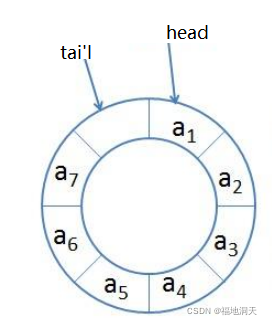
为了能够使用head == tail的判定
条件,一般认为这个情况是满的。
为保证空间一定能存放下k个元素,将数组空间+1即可满足。
此时判断为空的条件:head == tail
判断为满的条件:head = tail+1
注意:多出来的一个空间在数组中时随机的,并不是在数组末尾。
画图:
环形只存5个数据,开辟了6个空间
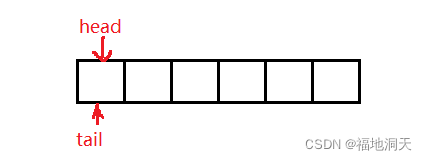
经过一系列插入,删除操作:

再插入值
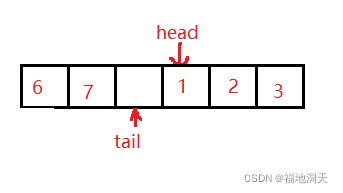
此时已经插入了5个值了,队列已经满了,判定条件就成了tail+1 == head
这是多次插入和删除情况下的,若是不进行删除操作:
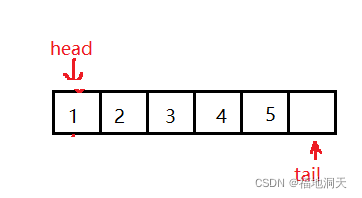
此时就已经满了。判定条件 tail == k
?
代码:
typedef struct {
//数组,头,尾,k
int* a;
int head;
int tail;
int k;
} MyCircularQueue;
bool myCircularQueueIsEmpty(MyCircularQueue* obj);
bool myCircularQueueIsFull(MyCircularQueue* obj);
MyCircularQueue* myCircularQueueCreate(int k) {
//分配空间
MyCircularQueue* obj = (MyCircularQueue*)malloc(sizeof(MyCircularQueue));
//结构体内部的数组也需要开辟空间,为方便找到循环结束条件多开一个单位
obj->a = (int*)malloc(sizeof(int)*(k+1));
//初始化
obj->head = obj->tail = 0;
obj->k = k;
return obj;
}
bool myCircularQueueEnQueue(MyCircularQueue* obj, int value) {
//判断循环队列是否已满
if(myCircularQueueIsFull(obj))
{
return false;
}
else
{
obj->a[obj->tail] = value;
//更新tail
//如果走到尾的话,就归0
if(obj->tail == obj->k)
{
obj->tail = 0;
}
else
obj->tail++;
}
return true;
}
bool myCircularQueueDeQueue(MyCircularQueue* obj) {
if(myCircularQueueIsEmpty(obj))
{
return false;
}
else
{
//更新头
if(obj->head == obj->k)
{
obj->head = 0;
}
//数据覆盖即可
else
obj->head++;
return true;
}
}
int myCircularQueueFront(MyCircularQueue* obj) {
if(myCircularQueueIsEmpty(obj))
{
return -1;
}
else
{
return obj->a[obj->head];
}
}
int myCircularQueueRear(MyCircularQueue* obj) {
if(myCircularQueueIsEmpty(obj))
{
return -1;
}
else
{
if(obj->tail == 0)
{
return obj->a[obj->k];
}
else
return obj->a[obj->tail-1];
}
}
bool myCircularQueueIsEmpty(MyCircularQueue* obj) {
return obj->head == obj->tail;
}
bool myCircularQueueIsFull(MyCircularQueue* obj) {
if(obj->head==0 && obj->tail == obj->k)
{
return true;
}
else if(obj->tail+1 == obj->head)
{
return true;
}
else
return false;
}
void myCircularQueueFree(MyCircularQueue* obj) {
free(obj->a);
free(obj);
}